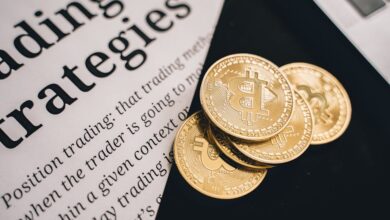The Gold Standard Revisited: Historical Insights and Modern Trends in Gold Investment and Market Dynamics

The gold standard has long been a pivotal element in the history of currency, shaping economies and influencing monetary policies across the globe. Historically, nations adopted gold as a backing for their currencies, providing a tangible value that instilled confidence in the financial system. This article delves into the evolution of the gold standard, tracing how gold-backed currencies have shaped economies and offering insights into their historical significance. As we navigate through various sections, we will explore gold's role as a safe haven asset during times of economic uncertainty, revealing why investors often turn to gold investments when markets falter. Furthermore, we will analyze modern implications of the gold standard, including current gold market trends, investment strategies involving gold ETFs, and the impact of gold prices on global demand. From gold mining and refining practices to the intricacies of gold smuggling and the allure of luxury gold collectibles, this exploration will uncover the multifaceted relationship between gold and the financial landscape, shedding light on its enduring value in an ever-evolving economy. Join us as we embark on a journey through time, examining the significance of gold and its lasting impact on currency and investment.
- 1. The Evolution of the Gold Standard: How Gold Backed Currency Values Shaped Economies
- 2. Gold as a Safe Haven Asset: Understanding Its Role in Times of Economic Uncertainty
- 3. Modern Implications of the Gold Standard: Analyzing Current Gold Market Trends and Investment Strategies
1. The Evolution of the Gold Standard: How Gold Backed Currency Values Shaped Economies
The evolution of the gold standard has played a crucial role in shaping economies throughout history. Initially, gold was used as a medium of exchange due to its intrinsic value, durability, and divisibility. As trade expanded, the need for a stable currency led to the establishment of the gold standard, where currencies were backed by a fixed quantity of gold, ensuring that paper money could be exchanged for physical gold.
This system provided a sense of security and stability in the gold market, fostering trust among nations and facilitating international trade. Central banks accumulated gold reserves as a safeguard against inflation and economic downturns, positioning gold as a safe haven asset during times of uncertainty. The relationship between gold and inflation became increasingly significant, with fluctuations in gold prices often mirroring economic conditions.
Throughout the years, gold mining and production have evolved alongside the gold standard. Innovations in sustainable gold mining practices have emerged to meet the growing global gold demand while minimizing environmental impact. Gold recycling has also gained traction, allowing for the recovery of gold from electronic waste and other sources, further supporting the gold market.
As the global economy shifted in the 20th century, many countries abandoned the gold standard, leading to the introduction of fiat currencies. However, gold remains a vital asset in investment portfolios, with gold ETFs and gold futures offering investors a way to gain exposure to gold prices without holding physical gold. The allure of luxury gold jewelry and collectibles continues to thrive, while gold coins investing has become a popular strategy for those looking to diversify their assets.
In recent years, the rise of cryptocurrencies has sparked a renewed interest in gold, with some viewing it as a complementary asset to digital currencies. The ongoing analysis of gold market trends reveals that, despite the fluctuations in gold prices, the demand for gold remains resilient, driven by its historical significance and role as a hedge against economic instability.
In summary, the evolution of the gold standard has deeply influenced economic systems worldwide. While the direct backing of currencies by gold has diminished, the legacy of gold as a reliable store of value persists, underpinning the continuing relevance of gold in today’s financial landscape. The intricate dynamics of gold trade, production, and investment continue to shape the global gold market, ensuring that gold remains a pivotal player in the realm of finance.
2. Gold as a Safe Haven Asset: Understanding Its Role in Times of Economic Uncertainty
Throughout history, gold has consistently been perceived as a safe haven asset, particularly during periods of economic uncertainty. As markets fluctuate and geopolitical tensions rise, investors often turn to gold investment to protect their wealth. This trend can be attributed to the intrinsic value and stability that gold offers, making it a reliable store of wealth when other assets, such as stocks or real estate, become volatile.
In times of crisis, such as during financial downturns or inflationary periods, gold prices typically see an uptick as demand increases. Investors flock to physical gold, including gold bars and gold coins, as they seek to secure their assets against potential losses in fiat currencies. The gold market trends during such times indicate a shift in investment strategies, with many individuals and institutions opting for gold ETFs or gold futures as a means to gain exposure to the commodity without the need for physical storage.
Central banks also play a crucial role in the gold market, as they hold significant gold reserves to back their currencies and provide economic stability. The relationship between gold and inflation is particularly noteworthy; as inflation rises, the value of paper currency often diminishes, prompting a stronger interest in gold as a hedge against inflationary pressures. This dynamic is evident in the ongoing global gold demand, which has surged in recent years as investors seek to diversify their portfolios.
Moreover, the gold trade has evolved, with sustainable gold mining practices becoming increasingly important to consumers who prioritize ethical sourcing. Innovations in gold technology also allow for advancements in gold recycling, enabling the recovery of gold from electronic waste and reducing the need for new mining operations. This shift not only supports environmental sustainability but also contributes to a stable supply of gold in the market.
While the rise of cryptocurrency has introduced new options for investors, gold remains a timeless asset, often regarded as a more stable alternative. Luxury gold items, such as gold jewelry and gold collectibles, continue to hold value, further emphasizing the metal's enduring appeal as a safe haven asset. As we analyze gold market trends, it becomes clear that regardless of economic conditions, gold's status as a safe haven asset is unlikely to diminish, solidifying its place in financial portfolios worldwide.
3. Modern Implications of the Gold Standard: Analyzing Current Gold Market Trends and Investment Strategies
The modern implications of the gold standard continue to resonate in today’s financial landscape, particularly as global economic conditions evolve. While the gold standard itself has been abandoned by most countries, gold remains a crucial component of the global financial system, often viewed as a safe haven asset during periods of economic uncertainty.
Current gold market trends indicate a rising interest in gold investment as a hedge against inflation and currency volatility. As central banks increase their gold reserves, the demand for physical gold, including gold bullion and gold coins, continues to grow. This trend is further supported by the rising prices of gold, which can often be attributed to geopolitical tensions and economic instability. Investors are strategically diversifying their portfolios with gold ETFs, gold futures, and physical gold to mitigate risks associated with other asset classes.
Moreover, the emergence of gold recycling has become an integral part of the gold market analysis. This sustainable approach not only supports gold production but helps in meeting global gold demand without excessive mining. In addition, luxury gold jewelry and gold collectibles maintain their appeal, tapping into a market that values both aesthetics and investment potential.
The intersection of gold and cryptocurrency has also been a topic of discussion among investors. Many view gold as a more stable alternative to cryptocurrencies, which are often characterized by high volatility. This relationship highlights gold’s enduring role as a reliable store of value.
However, the gold trade faces challenges such as gold smuggling and unethical mining practices. Sustainable gold mining initiatives are becoming increasingly important as investors seek transparency in gold sourcing. As the market evolves, the implications of the gold standard continue to shape investment strategies, with a focus on responsible practices and innovative technologies in gold refining and production.
In summary, the modern gold market is characterized by a complex interplay of factors that influence gold prices and investment strategies. As investors navigate these dynamics, understanding the implications of historical practices like the gold standard can provide valuable insights for future gold investments.
In conclusion, the historical use of the gold standard has profoundly influenced economic systems, shaping how currencies are valued and traded. As we have explored, gold has consistently served as a safe haven asset during times of economic uncertainty, providing stability when confidence in fiat currencies wanes. Today, understanding modern implications of the gold standard is crucial for investors navigating the complexities of the gold market.
With the rise of gold ETFs, gold futures, and a growing interest in gold coins investing, individuals and institutions alike are recognizing the value of gold reserves as a hedge against inflation and economic volatility. The current trends in gold prices reflect a robust global demand, driven by not only traditional jewelry and collectibles but also technological advancements in gold recycling and sustainable gold mining practices.
As central banks continue to bolster their gold holdings, the interplay between gold and cryptocurrency further complicates the landscape, highlighting the evolving nature of gold as both an investment and a financial safeguard. Whether one is interested in physical gold, gold bullion, or luxury gold items, the gold market remains a critical area for analysis and investment strategy. Moving forward, staying informed about gold market trends will be essential for those looking to capitalize on this timeless asset.
References
(Include relevant sources here)





